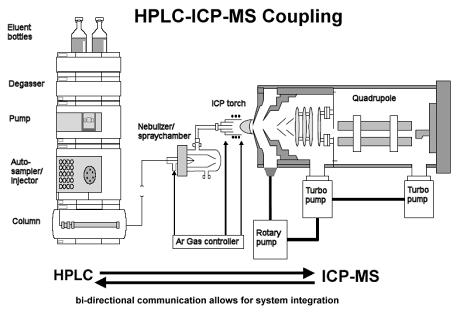Liquid chromatography (LC) is an extremely versatile technique with numerous advantages:
- both the stationary phase and the mobile phase may be altered to achieve the desired separation,
- separations can be further enhanced by the addition of additives (chiral additives, ion pair reagents, surfactants) to the mobile phase,
- separations can be enhanced by changing the mobile phase during the analysis (gradient elution),
- an enourmous variety of stationary phases are commercially available based on a rich variety of separation principles such as
- normal phase chromatography (NPC)
- reversed phase chromatography (RPC)
- reversed phase ion pair chromatography (IPC)
- micellar chromatography
- ion exchange chromatography (IEC)
- size exclusion chromatography (SEC).
- Usually, minimum sample preparation is required.

Fig. 1 Coupling of HPLC with ICP-MS
Liquid sample introduction is the standard in ICP-MS, therefore coupling of liquid chromatography with ICP-MS in the simplest form is just the connection of the column outlet with the nebulizer of the sample introduction system via a transfer tubing. It is not a surprise that the hyphenated system resulting from the coupling of liquid chromatography and ICP-MS is the most often used system for speciation analysis related to the ICP-MS detection. About 1/3 of all publications on speciation analysis related to ICP-MS describe the use of LC-ICP-MS.
LC-ICP-MS has important advantages for speciation analysis:
- Complex chromatograms are reduced to simple "elementograms"
- Quantification of even unknown element species is possible with respect to the detected element due to compound independent sensitivity without the necessity of having standards.
- All molecular information is lost
- Species characterization is limited to chromatographic retention times
- contamination with metallic compounds arising from the
chromatographic system (pump, valve, tubing) or the stationary and
mobile phase,
- dispersion effects, that means the influence on the sample introduction system on the separation power of the chromatographic system,
- plasma solvent load effects, that means the influence on the mobile phase on the stability and ionization power of the inductively coupled plasma.
On the other hand, the negative influence of dead-volumes and other poor design factors on the chromatographic separation power is the more pronounced the smaller the flow rate of the system is. Therefore, especially careful design considerations are necessary for nano-HPLC coupling while standard system are less critical.
With respect to the type of MS detection system, one has to consider the transient character of the chromatogtaphic signals. Depending on the number of simultaneous channels that have to be monitored (only one in the simple case of a single element speciation), systems that can either simultaneously collect data on different channels or can do fast sequential measurements will have advantages.
application
The HPLC methodology allowed the baseline separation of arsenite (AsIII), AsB, DMA, monomethyl arsonic acid (MMA) and arsenate (AsV). The chromatographic data is displayed automatically in the XSeriesII PlasmaLab software package following analysis and an example of the chromatographic separation of arsenic-containing standards is shown in Figure 1. The PlasmaLab software
enables flexible data acquisition and integration parameters, automatically applicable to a series of sample analyses in an experiment.
Quantification of arsenic-containing species was performed by external calibration. A blank and calibration standards of 1, 5, 10 and 25 ng g-1 of each of the five arsenic-containing standards were used to generate species specific calibration curves. The calibrations for AsB and DMA are shown for reference in Figure 2. The CRM DORM-2, certified for AsB was extracted and analyzed in triplicate to verify the HPLC-ICP-MS procedure. A method blank was prepared and analyzed to correct for any
contamination.
source : http://www.speciation.net/Public/Document/2007/06/21/2914.html
http://www.thermo.com/eThermo/CMA/PDFs/Articles/articlesFile_26473.pd



Tidak ada komentar:
Posting Komentar